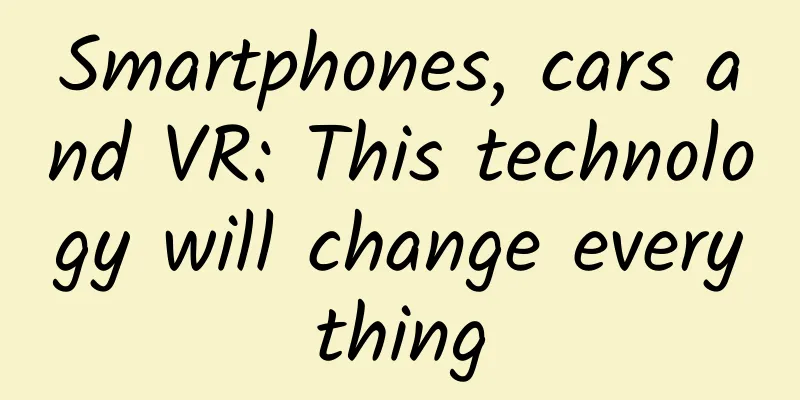Smartphones, cars and VR: This technology will change everything

|
Perhaps the coolest news at the 2016 Consumer Electronics Show (CES) was the announcement by Lenovo and Google (Weibo) that they would work together to develop consumer smartphones based on Project Tango. Like similar efforts from Microsoft, Apple and Intel, Project Tango's technology seeks to give smartphones and other devices the ability to perceive depth and space like the human eye. Such technology has far-reaching implications: apps could measure the dimensions of furniture or guide you directly to a friend in a crowded crowd. This represents the future of technology as our devices learn more about the world around them and it will be integrated into every type of technology we use. SoftKinect, a startup acquired by Sony in late 2015, has been developing this technology for some time. In fact, the company's technology has been used in the high-end center console products of BMW 7 Series models to achieve gesture control. Users can answer calls or turn on music just by waving their arms. According to Eric Krzselo, chief marketing officer at SoftKinect, this is just the beginning of what these apps will be able to do. He said that the most intuitive application of this technology in the initial stage is in smartphones. Combined with camera functions such as autofocus, the perception of depth of field will be of great help. As the sensor is added to more phones, developers will be able to enable apps to "read" the movement of a user's arm in three-dimensional space, which means users can interact with digital objects in virtual or augmented reality environments. In short, if I use an Oculus Rift helmet with a SoftKinect sensor, I can wave my arms in front of my eyes and see the corresponding operations on the screen. I no longer need to use a handle or keyboard, all operations will be completed through arm movements. As a subsidiary of Sony, SoftKinect must have a close relationship with Sony, which Corzello said means that the company's technology will appear in future PS4 virtual reality headsets. However, just as Sony sells image sensors to Apple and other competitors, SoftKinect will also sell sensors to car manufacturers, mobile phone manufacturers, and even Facebook's Oculus to help them develop suitable products. In another VR demo, I used SoftKinect’s gesture technology to manipulate a holographically projected car center console and press virtual buttons. Microsoft and Intel have also invested heavily in this area, and similar sensors are already used in Intel-powered systems such as the Microsoft HoloLens and HTC Vive. If you want to see what the future holds, you can check out the virtual reality painting project Tiltbrush. In short, future smartphone hardware will become more powerful by understanding the world around it in unprecedented ways. |
<<: 11 Predictions for Web Design Trends in 2016
>>: Kill DingTalk? Is this a sad story?
Recommend
What is the character setting of short videos? How to create a short video personality?
We often hear some words about personality, such ...
From cognition to practice, Anshen has seven steps to create a new takeaway store with 9999+ orders
From cognition to practice, seven steps to create...
[Case] How can live streaming products quickly acquire high-quality iOS users?
Video live streaming products have become very po...
The points system has raised questions about the high energy consumption of new energy vehicles, and the pure electric route may be revised
After the introduction period and entering the gr...
Qoros Auto seeks to make a comeback, launching 26 new models in 5 years, investing 10 billion yuan a year
Recently, Qoros Auto announced an ambitious five-...
When the weather gets cold, I always want to eat...How can I eat to better cope with the cold winter?
In cold weather, in addition to wearing more clot...
How to set user growth goals? Here are 6 lessons learned!
Setting growth targets is difficult, but the bene...
Does your child have hand, foot and mouth disease? Infusion is not a must
Reading time: 5 minutes, the full text is about 8...
Every bite you eat is responsible for your brain
After the various fatty acids in food enter the h...
Can eating less sugar reduce the risk of cardiovascular disease? Research shows: It depends on what kind of sugar you eat
Written by: Nan An It’s common to hear that “eati...
Regarding community operation, I have 5 routines here!
Group administrator: @李根同学, please do not post ad...
Zhihu account anti-ban rules and product promotion guidelines!
1. My experience of selling products on Zhihu, fr...
The number one vegetable in autumn and winter, why does it unite the stomachs of both the north and the south?
Stocking up on radishes means stocking up on the ...
How to use iPad at work to improve work efficiency
How to be more efficient with iPad requires using...
How to use data analysis to acquire customers at low cost?
This article is organized as follows: How to exte...









